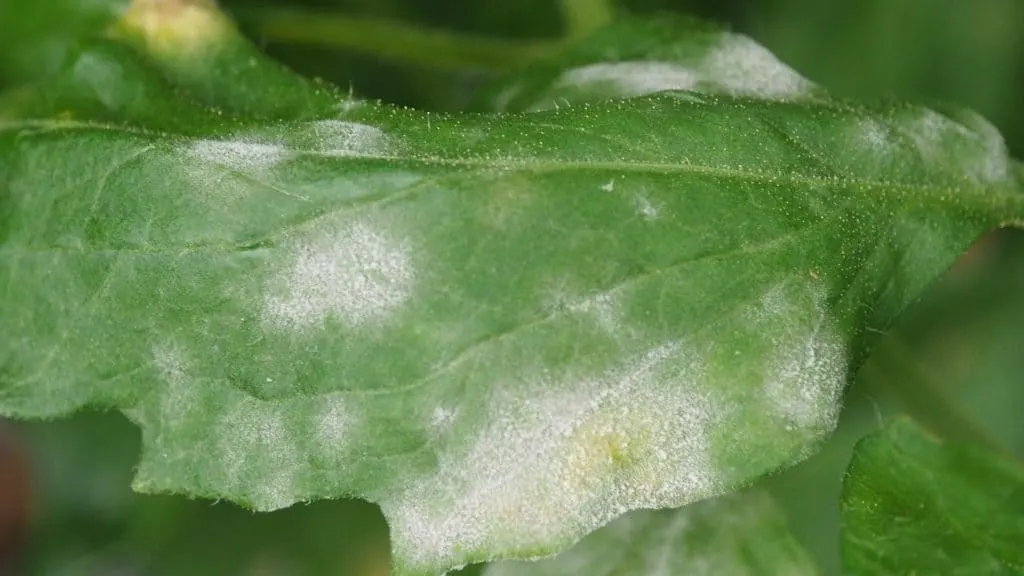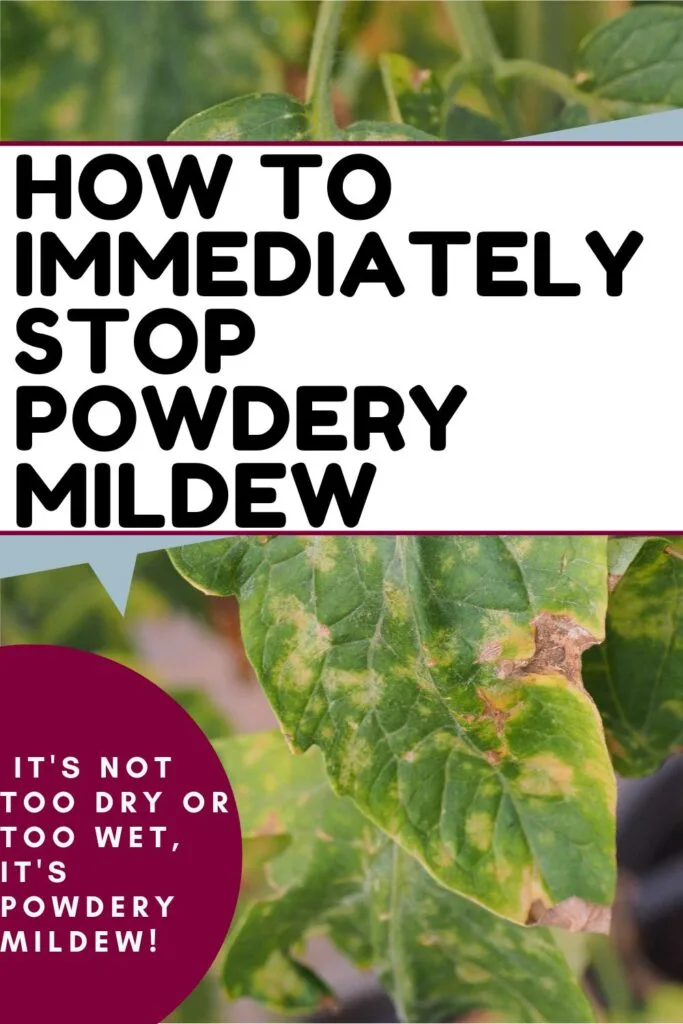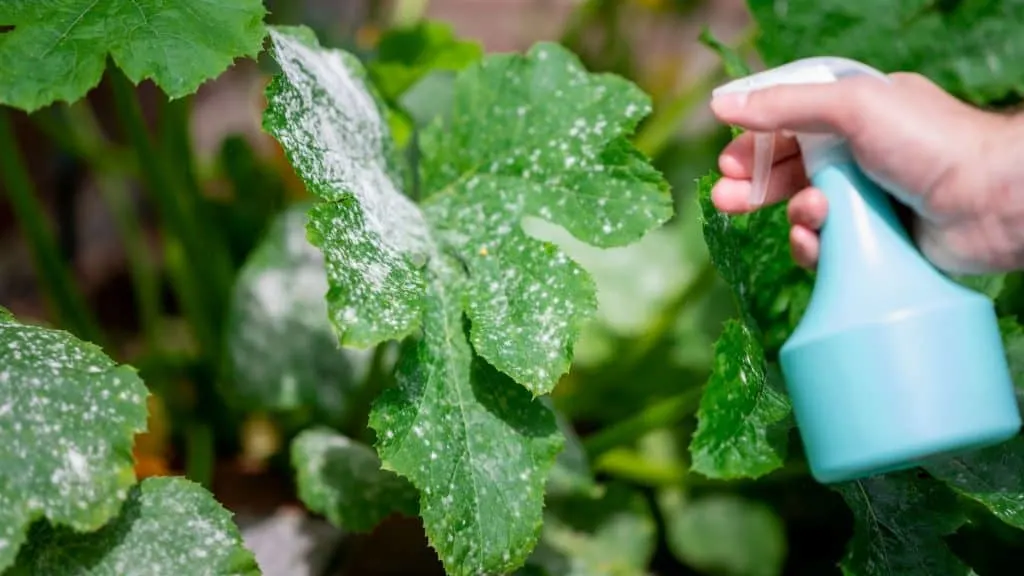There’s nothing more defeating than taking time to nurture and grow your vegetable plants, only to find that despite your care and attention, they’re plagued with mold and mildew.
Powdery mildew is a problem many gardeners encounter. Still, it doesn’t have to ruin your vegetable garden if you can commit to eliminating it or managing it, so it doesn’t cause damage to your plants.
It’s not anything that will immediately kill your vegetable garden. Still, it will cause a deterioration in the health of your plants, leeching nutrients and causing the leaves to shrivel up and turn yellow.
This is a fungus that affects just about all plants you want to grow in your garden, so you need to be able to identify it to address it when and if it appears.
If you notice that your plant suddenly looks like it’s covered in powder on the leaves, stem, or flowers, that’s a sign of mildew.

One thing you want to do is see if you’ve given your plants enough room to grow. Sometimes, people crowd their gardens so tight with plants that the air doesn’t circulate properly, contributing to the humidity and mildewing of the plants.
You want to make sure they’re getting plenty of sun, too. If they’re growing in too much shade, it could worsen the mildew problem. You also want to get your soil conditions just for increasing – not overly dry or too saturated with fertilizer.

If you’re constantly dealing with mildew issues, then make sure you invest in some of the preventative products on the market to help stave off this type of disease and keep your garden healthy.
Once the powdery mildew appears, you’ll have to try to remedy the situation. There are a variety of solutions people swear by – including vinegar, milk, baking soda, mouthwash, and Neem oil.
Not every plant responds the same in every climate to these quick fixes, so you may have to test them out to see what works best on your vegetables. Mildew will thrive in dry, warm climates, so even water can sometimes help to remove the mold.
Read: 5 Free Ways to Design Your Vegetable Garden

The most susceptible vegetable plants to powdery mildew are:
While most plants are susceptible to this issue, you’ll find it on plants like cucumbers, lettuce, potatoes, squash, peppers, tomatoes, and zucchini plants more often. The spores can spread with the wind, so try to catch and treat them early on to protect the rest of your crop.
- Melons
- Zucchini
- Squash
- Pasley
- Pumpkins
- Lettuce
- Cucumbers
- Potatoes
- Tomatoes
- Fruit Trees
In the past, when I’ve dealt with powdery mildew, it always started on my Tomato plants. I’ve tended to find that if I plant my veggies too early in the season, I deal with this. Now I wait as long as possible for the garden to dry out.
Read: The Best Vegetable Plants To Grow for Beginners

Here are things to try to get rid of Powdery Mildew on Plants
If the plant is more established, you can remove the affected leaves. Then go about spraying the plant. Here is a popular solution that I used in the past and had success with.
A homemade solution: mix one tablespoon of baking soda with a teaspoon of vegetable oil and one teaspoon of liquid soap (not detergent) in a gallon of water. Spray on plants every one to two weeks.
Be aware that this mix can burn the leaves of plants, so you will need to put it in a sprayer and spray the plants evenly. To prevent your plants from being burned by the mixture, water them well a few days before application.
Last year, I used this mixture on our plants, and it worked fine. I was still able to have an excellent harvest of tomatoes and zucchini. The key is to catch it early.
Always apply the mixture early morning or late evening when the sun isn’t blasting the plants.
Effective organic fungicides for treating powdery mildew include sulfur, lime-sulfur, neem oil, and potassium bicarbonate. These are most effective when used before infection or when you first see signs of the disease.
Although it may seem daunting, identifying and removing mold and mildew from your garden is doable. With a few simple steps – like using baking soda or hydrogen peroxide to kill the mold or mildew, ensuring good air circulation, and removing any affected plants – you can keep your garden healthy and thriving all season long.
Have you had any experience dealing with mold or mildew in your garden? What worked (or didn’t work) for you? Let us know in the comments below.
Check out More Gardening Tips:
- 8 Most Clever Vegetable Gardening Tips for the Lazy Gardener
- The Top Low Maintenance Shade Loving Perennials
- Top Low Maintenance Perennials That Bloom All Summer
- 13 Perennials You Should Not Cut Back in the Fall
- The Best Perennials to Plant with Tulips
- 16 Best Climbing Flowering Perennials for Your Garden
- The Perfect Easy to Grow Full Sun Low Maintenance Perennials
- A Beginner’s Guide to Planting and Growing Your Own Spring Flowers

Lancelot
Thursday 10th of August 2023
I've found that a couple of tablespoons of baking soda and a teaspoon of Dawn Platinum in a gallon of non-chlorinated water using a misting sprayer applied generously on all the affected areas does the trick and keeps both mold and mildew at bay, allowing your plants to thrive and produce the best quality fruit, veggies, and herbs without the use of chemicals or synthetic compounds you'll be ingesting later from your harvest. Additionally, if you have green mold growing on your topsoil be sure to give it a good dose of the solution and till the soil around your plants to provide better aeration of the soil and help to prevent future mold from forming. If you're using potted outdoor plants move them according to the path of the sun, especially towards the end of summer into the early fall months. Additionally, keep the potted plants from sitting directly on the ground with anything you have including a brick, stones, a cut piece of 2X4, or evenly cut branches to allow better air flow and drainage. Be sure not to block the holes so the pots can drain properly.